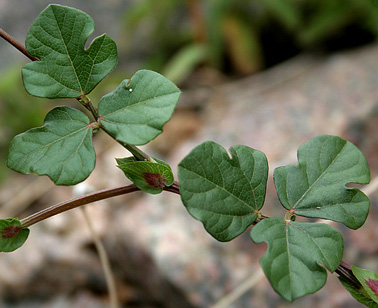|
Botanical Name:
Vigna trilobata
Mudgaparni consists of dried whole plant of Vigna trilobata
(L.) Verde (Synonym Phaseolus trilobus Ait), Family Fabaceae
Common Name(s) in English & Indian Languages
Sanskrit: Suryaparni, Saha
Bengali: Muganee
English: Wild Gram, Three-Lobe-Leaf Cowpea
Guajarati: Janglee Maga
Hindi: Janglee Mung
Kannada: Abaregid
Malayalam: Kattuppayaru
Marathi: Ranmug
Punjabi: Mugvan
Tamil: Kattuppayaru, Panippayavu
Telugu: Pilla pesara
Botanical description:
Suberect or erect, diffusely spreading hairy herb, 30 to 90
cm high. Leaves alternate, trifoliolate, leaflets
elliptic-ovate or oblong-lanceolate, apex acute to
acuminate, 5-10 cm long. Flowers yellow, bisexual, terminal,
usually 8-12 on c 10-15 cm long peduncle. Pods 3-5 cm long,
cylindrical, hairy, and terete with a short hooked beak.
Seeds 10-15, oblong with square ends, about 3 mm long
Parts used:
Whole Plant
Major chemical constituent:
Sterols
Therapeutic uses:
• Fever (Jvara)
• Cough (Kasa)
• Worm infestation (Krmi)
• Pthisis (Ksaya)
• Diseases of skin (Kustha)
• Excessive vaginal discharge (Pradara)
• Gout (Vatarakta)
• Burning sensation (Daha)
• Burning sensation due to Pitta dosa (Pitta daha)
• Rat poisoning (Musika visa)
• Wound inflammation (Ksata sotha)
• Alcoholism (Madya trsna) |
|

|
|
|



